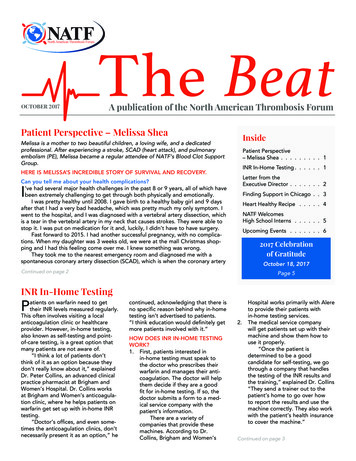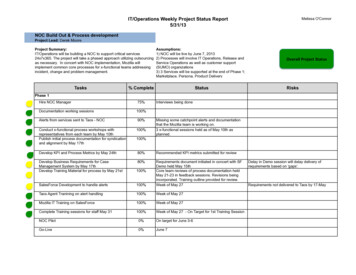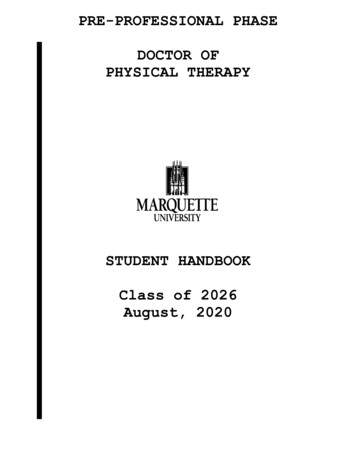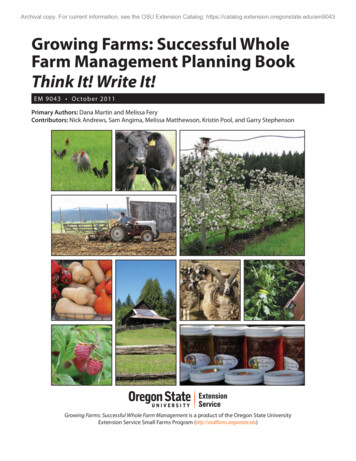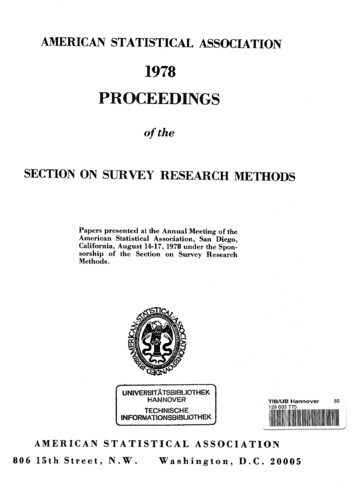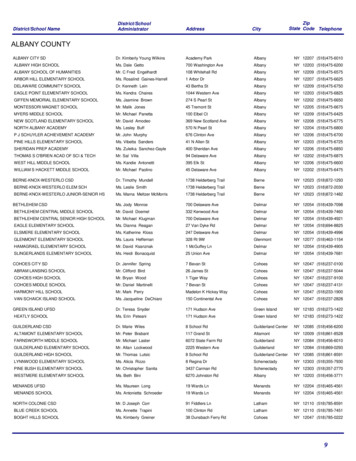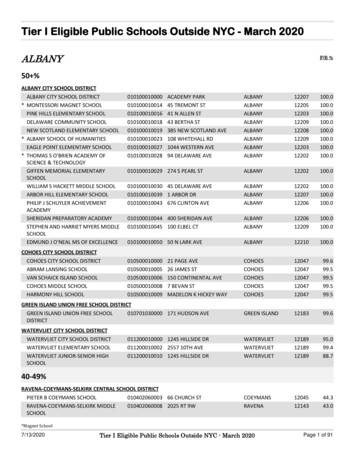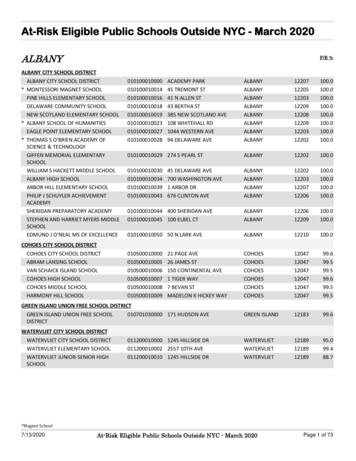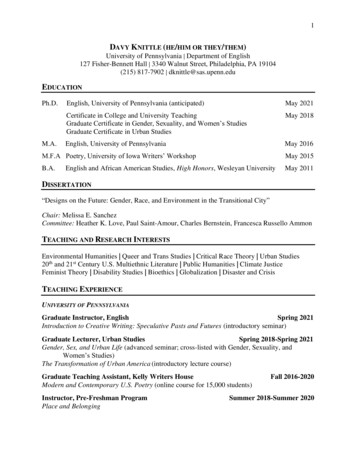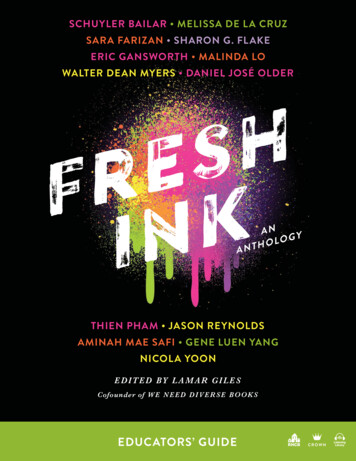
Transcription
SCHUYLER BAIL AR MELISSA DE L A CRUZSARA FARIZAN SHARON G. FL AKEERIC GANSWORTH MALINDA LOWALTER DEAN MYERS DANIEL JOSÉ OLDERHSERF KINAANOGYLONTHTHIEN PHAM JASON REYNOLDSAMINAH MAE SAFI GENE LUEN YANGNICOL A YOONE D I T E D BY L A M A R G I L E SCofounder of W E N E E D D I V E R S E B O O K SEDUCATORS’ GUIDECROWN
EVERYONE HAS THEIR OWN STORY TO TELL.ABOUT THE BOOKCareful—you are holding fresh ink. And not hot-off-the-press,still-drying-in-your-hands ink. Instead, you are holding twelvestories with endings that are still being written—whose nextchapters are up to you.Because these stories are meant to be read. And shared.Thirteen of the most accomplished YA authors deliver a labeldefying anthology that includes ten short stories, a graphicnovel, and a one-act play about topics like gentrification,acceptance, untimely death, coming out, and poverty, andranging in genre from contemporary realistic fiction toadventure and romance. This collection will inspire you tobreak conventions, bend the rules, and color outside the lines.All you need is fresh ink.CONTRIBUTORS TO THISANTHOLOGY INCLUDE:SCHUYLER BAILAR, the first openly transgender NCAAmen’s Division I swimmer in his writing debutwinnerMELISSA DE LA CRUZ, #1 New York Times bestsellingTHIEN PHAM, graphic novelist, comic artist, and educatorauthorDANIEL JOSÉ OLDER, International Latino Book AwardAward winnerJASON REYNOLDS, New York Times bestselling author,National Book Award finalist, Printz Honor recipient, NewberyHonor recipient, three-time Coretta Scott King Honor recipient,Schneider Family Book Award winner, two-time winner of theWalter Dean Myers Award for Outstanding LiteratureERIC GANSWORTH, American Book Award winnerAMINAH MAE SAFI, debut authorLAMAR GILES, anthology editor, founding member ofWe Need Diverse Books, Edgar Award nomineeGENE LUEN YANG, National Book Award finalist,Printz Award winner, National Ambassador for Young People’sLiterature 2016–2017SARA FARIZAN, Lambda Literary Award winnerSHARON G. FLAKE, two-time Coretta Scott King HonorArt used under license from Shutterstock.comGrades 7 and up · Lexile: HL700LHC: 978-1-5247-6628-3GLB: 978-1-5247-6629-0EL: 978-1-5247-6630-6CD: 978-0-525-59565-6MALINDA LO, William C. Morris YA Debut Award finalist,Andre Norton Award finalist, three-time Lambda Literary AwardfinalistWALTER DEAN MYERS, Printz Award winnerNICOLA YOON, #1 New York Times bestselling author,National Book Award finalist, Printz Honor recipient,Coretta Scott King–John Steptoe Award for New Talentwinner, Walter Dean Myers Award Honor Book recipientH “A POWERFUL and varied collection.” —Booklist, StarredH “The stories are distinct in themes, subjects, genres, and formats, creating an INCLUSIVE, AUTHENTIC,AND INCREDIBLE COLLECTION.” —School Library Journal, Starred
DISCUSSION QUESTIONS AND ACTIVITIESEach question invites readers to respond or reflect orally or artistically. The readers may also respond in writing in their journals.“ERASER TATTOO” by JASON REYNOLDS“MEET CUTE” by MALINDA LO Find three definitions of gentrification. What commonelements do you notice? What do some see as the benefits ofgentrification? How does gentrification hurt communities? Whydoes gentrification occur? How do you think the process ofgentrification changes and shapes communities? What aboutgovernment policies? Watch an episode each of The X-Files and Star Trek (the originalseries). What do you think of the characters?Additional / Define cosplay. Why do you think this practice is popular? S ome of the characters in this story display sexist attitudes. Forexample, a male DenCon attendee states, “I hate it when girlsthink they can cosplay men. . . . It always looks so lame.” (p. 15)Another says, “Somebody’s on the rag.” (p. 16) Reflect on thesecomments. Why is such language destructive? W hen discussing the report that Sulu will be gay, Nic highlights,“I think it’s about time, and I’m happy that Sulu got to be thegay character. It’s too bad there can be only one, though, evenin the Star Trek universe.” (p. 17) Reflect on what she said. Writean argument on the importance of representation in media. What do you notice about the effects of gentrification ondifferent parts of a community? Who seems to have power inthe process? Who is not empowered? Reflect on the state ofyour community. Do you notice any patterns or changes? Whois coming? Who is going? What do the businesses look like?What are the centers of your community? T he lights go out at the convention center and hysteria ensues.Nic’s claustrophobia sets in. She and Tamia escape the mainconvention floor and go into a hallway. Tamia asks, “Whatabout you? Are you . . . like Sulu?” (p. 29) Why do you thinkshe asks this question? The setting is significant to this story. It is a character in itself.Describe the Brooklyn neighborhood that Shay and Dantelive in. In what ways are they “witnessing the neighborhoodrearrange itself ”? (p. 5) Why did Nic suppress a sigh when Wesley joined them? Describe Shay and Dante’s relationship? How did it evolve? Why is Shay’s family moving? Visually represent how youimagine Shay’s new home using mixed media (i.e., collage,diorama, painting). A young white couple is moving into Shay’s old house withoutwaiting for her family to finish moving out. What largermeaning could this hold? Write a poem to express the feelings of Shay or a memberof her family while packing and preparing to move to NorthCarolina. She explains that her future career goal is to be a marinebiologist. She says, “Somebody gotta care for all the stuffunderwater that nobody can see. It’s a beautiful world downthere, full of living things that most folks don’t understand.”(p. 7) Why do you think Shay wants to be a marine biologist?How do you think her career goals relate to what is happeningin her community? The pairing of eraser and tattoo is interesting. Unpack the title“Eraser Tattoo” and how it may connect to the theme of thisshort story. Write a paragraph defending your position.Correlates to Common Core Standards CCRA.READING 1, 2, 3, 9; CCRA.WRITING 1,9; CCRA.LANGUAGE 3, 4; CCRA. SPEAKING AND LISTENING 1, 2, 3, 4 I magine what Nic texted to Tamia. (p. 37) What do you thinkhappens after DenCon? Why? What signs do you get from thestory for your answer?Correlates to Common Core Standards CCRA.READING 1, 3, 4; CCRA.WRITING 1, 3,8; CCRA.LANGUAGE 4; CCRA. SPEAKING AND LISTENING 1, 2, 3, 5“DON’T PASS ME BY”by ERIC GANSWORTH Watch the video “A Chosen Exile: A History of Racial Passingin American Life” at youtube.com/watch?v toyjv27q17E.Read the memoir article “My mother spent her life passing aswhite. Discovering her secret changed my view of race—and myself ” at f/?utm term .d0d70e2feb46.Then read us8.campaign-archive.m/?u 42a60b451fd1cbd5c894f6f2b&id b15fd225fc&e b7bb9ee7e4 tive-american-program. Identify the main ideas of the video and articles.What questions do these texts spark? W hen and where does Gansworth’s story take place?
In the opening scene, Hayley Simpson’s eyes tell the narrator,“Don’t blow my cover, Doobie, if you know what’s good foryou.” (p. 38) Explain what the cover is. Select a song that could symbolize the relationship betweenShirin and Jeffrey. Explain your choice.Correlates to Common Core Standards CCRA.READING 1, 2, 3, 4, 7; CCRA.WRITING 1,4, 8; CCRA.LANGUAGE 4; CCRA. SPEAKING AND LISTENING 1, 2, 4 Doobie notes, “We each made decisions about how Indianwe appeared, and we respect each other’s decisions.” Does herespect Hayley’s choices? Cite the story in your answer.“TAGS” by WALTER DEAN MYERS Hayley had to repeat a year. She returns to school with a newappearance. Why? At the beginning of the play, we watch Big Eddie tagging a wallamong other teenagers. What is tagging? Is Big Eddie alive? Howdo you know? What is “Rez Amnesia”? (p. 42) Why does Hayley have RezAmnesia? Discuss the following moments, focusing on marginalization: when the classmates say that Doobie’s skin is “embedded[with] dirt” (p. 46) when the teacher implores the students to “Please wipeany makeup off before your turn. We don’t want it stainingon Annie’s skin. You want her to be normal colored for thepeople who come after you.” (p. 51) the discussion on page 52 about the assignment serving as aself-portrait for the majority of the class In your journal, reflect on the concept of passing. Why do youthink people choose to pass? How does that make you feel?Correlates to Common Core Standards CCSS.ELA-LITERACY.CCRA.READING 1, 2, 3,4, 7; CCRA.WRITING 1, 4, 8; CCRA.LANGUAGE 4; CCSS.ELA-LITERACY.CCRA. SPEAKINGAND LISTENING 1, 2, 4“BE COOL FOR ONCE”by AMINAH MAE SAFI Who is your favorite band or musician? Write a narrative aboutthe best concert you have been to, or imagine a concert youhave not attended and write about that. Describe your first crush. Did you approach your crush? Whathappened? If not, what held you back? Jeffrey came to Shirin’s favorite band’s concert. Why was thisgesture significant? What does Francesca mean when she saysthat Shirin should “try overreaching for once”? (p. 58) Why is the band, whose members are named after “tragichistorical queens” (p. 58), a unique backdrop for this interactionbetween Shirin and Jeffrey? “Oh no. I’ve really got to figure out which of the Twelve ImamsI pissed off so I can beg forgiveness.” (p. 67) What does thisquote say about how Shirin is feeling? Reflect upon the last line: “If only her life could be cool, foronce.” (p. 71) Is her life not cool? Will Shirin and Jeffrey havea relationship that both of their families and communitiesembrace? Does this matter? Reflect on the following statement from Eddie: “When that olddude told me you could still be in the world as long as peoplekept you in their minds, I knew what I had to do. They see thesetags and they remember.” (p. 74) Why do you think Walter Dean Myers wrote this story as aplay? Does it work? Explain why or why not. How would thestory change if it was presented in an alternative format? D’Mario enters the hallway and “looks at the others withoutspeaking.” (p. 77) Big Eddie shouts to D’Mario, “Yo, this hallwayain’t big enough for everybody! Go someplace else.” Reflect onthis statement. Is Big Eddie really talking about space? Big Eddie says, “Being alive is walking the damned streets, andmaking love, and listening to some music. This is just hangingon to what you know is already gone. This ain’t nothing like nolife.” (p. 83) Discuss why these words are significant. What is thelarger lesson that he is trying to share? What is the most important line of this play? Discuss why. If the play moved from an urban setting, would the mood change? Create a visual representation of tags that Big Eddie, Willie,J-Boy, and D’Mario create. Transform any story of your choice into a play. What waschanged or omitted? Explain the decisions you made.Correlates to Common Core Standards CCRA.READING 1, 2, 3, 4, 7; CCRA.WRITING 1,3, 4, 10; CCRA.LANGUAGE 2, 5; CCRA. SPEAKING AND LISTENING 1, 2, 6“WHY I LEARNED TO COOK”by SARA FARIZAN “I have my moments of courage,” Yasaman says. (p. 87) In whatway does she demonstrate courage throughout the story? What have you done to impress someone you care about? Describe the moment in the grocery store checkout line.(p. 94) What assumption did the cashier make about Grandma?Do you agree with the grandmother’s reaction to Yasaman’sapology to the woman in line? Explain. What life lessons does Yasaman’s grandmother try to teach herthroughout the story? How could these lessons relate to yourown life? Use your journal to reflect on these questions.
Compose a journal entry based on one of the following quotes: “Cooking is like love. It should be entered into withabandon or not at all.” —Harriet van Horne “Food is symbolic of love when words are inadequate.”—Alan D. Wolfelt “If you really want to make a friend, go to someone’s houseand eat with him. . . . The people who give you their foodgive you their heart.” —Cesar Chavez By inviting Hannah to dinner the following week, what doesYasaman’s grandmother celebrate? Why is this such a big deal?Correlates to Common Core Standards CCRA.READING 1, 2, 3, 4, 5; CCRA.WRITING 1,4; CCRA.LANGUAGE 3, 4; CCRA. SPEAKING AND LISTENING 1, 2“A STRANGER AT THE BOCHINCHE”by DANIEL JOSÉ OLDER In an interview with Nightmare, Older said: “I think overallthere’s a great hunger out there to both see ourselves inspeculative literature and for stories that are about more thanjust ‘getting the girl’ or ‘killing the bad guy.’ Diversity is aboutequitable representation in characters and authors, yes, butit’s also about a diversity of story craft, of voice, of narrativestructure and flow. . . . This kind of thing is fascinating from anarrative and voice perspective and speaks to the need to undohomogeny in all aspects of the industry. Race and culture affectour perspective.” Write a personal response to this statement. Who is telling the story? Who is the “you” that the narratoraddresses? There are four main characters: Ramses Garcia Garcia,Oba Ade Iku, Rosie Gene Selwin, and the stranger. Create acharacter chart to help describe each of these characters. Howare they connected?“A BOY’S DUTY” by SHARON G. FLAKE Read Langston Hughes’s iconic poem “Harlem” (also knownas “A Dream Deferred”). What do you think it means to have adream deferred? Have you had this experience in your own life?When have you seen dreams “dry up” or “explode”? What doyou think is the difference? Respond to the following quote before you read the story: “Aboy’s got a duty to hold onto his dreams, I think.” (p. 132) Afterreading the story, return to this quote and reflect again. Read the first two paragraphs of the story. (p. 112) What do youknow about the narrator? His family? His long-term goals? Who is the sailor sitting at the counter who “hangs his head lowwhile he writes, then cuts his blue eyes at [the narrator] andsmiles”? (p. 114) Why does he stand out? The local newspaper calls the narrator “THE BOY WITHHIS EYES ON THE STARS.” He told his father that there’s“more to life than living on the farm.” (p. 115) Why does this goagainst what his father believes? Why does his father think theway he does? Why did the narrator paint the mural? Is it enough? Why orwhy not? The idea of duty is threaded throughout this story. Zakary,the narrator, is pulled in many directions by his father, by Mr.Jackson, by his peers, and by himself. How would each of thesecharacters define duty? Zakary plans to join the army. His father wrote to him thatWorld War II “is not the Negroes’ fight.” What does this mean?Anchor your response in the time period that the story is set in. Z akary is an artist. In his honor, create a visual representationof what the theme of this story is. Brooklyn, the setting, is such an integral part of the story.Describe Brooklyn before the Four Corners War.Correlates to Common Core Standards CCRA.READING 1, 2, 3, 9; CCRA.WRITING 1, 3,4, 5, 8; CCRA.LANGUAGE 4; CCRA. SPEAKING AND LISTENING 1, 3, 4 What did the stranger do to cause the commotion in theBochinche?“ONE VOICE: A SOMETHINGIN-BETWEEN STORY”by MELISSA DE LA CRUZ What does Ramses discover in the tenement the stranger runs into? Create a visual representation of the creature that tightenedaround Ramses’s ankles. What is the stranger’s role in the Scourlings? Ramses’s abuela’s sage advice: “Never leave a place the sameway you enter.” (p. 109) Reflect on what this means to the storyand how it connects to a larger life lesson.Correlates to Common Core Standards CCRA.READING 1, 2, 3, 6; CCRA.WRITING 1, 4,8; CCRA.LANGUAGE 3, 4; CCRA. SPEAKING AND LISTENING 1, 2 Preview the text. What do you notice about the format of thestory? Read the story, and revisit the format. Do you think itworks? Explain your answer. Why do you think the author chosethis structure? Reflect on these quotes from the story prior to reading: “Words matter as much as actions.” (p. 135) “It might seem weird but power washing the graffiti soquickly seemed to add to the injustice.” (p. 135)
“I wanted everyone to see the truth—that even Stanfordwasn’t free from this kind of hate.” (p. 135) “I wanted America to want me because I was already apart of the fabric of the country.” (pp. 136–137) “They’re words? . . . Where do you think violence starts?”(p. 138) In the first section “Graffiti,” the narrator is struck by how the“white spray-painted message glowed on the sandstone bricks ofJordan Hall.” (p. 133) How does this image impact her day? Julia Higgins’s car was vandalized. “Everyone was so concernedwith who committed these crimes, but no one seemed to caremuch about the targets.” (p. 141) Explain what the narratormeans by this statement. How did the campus react to the targeted, racist vandalism?The students? The administration? Jas tries to get Royce to understand her feelings. After some guysmake an insensitive remark to her, she says, “Maybe you shouldconsider what it’s like to be me when stupid, shallow guys talkabout how they only want to date Asian girls. Or how I feel whensomeone tells me we all look the same, or how frustrating it isbecause we’re all born to lose. Try playing second banana to thepretty-white-girl standard.” (p. 143) Discuss the role empathymust play in listening to and understanding the experiences ofothers. The narrator felt herself “growing angrier by the day.” (p. 144)Does this anger subside or does it transform? Justify your stance. What is the most important sentence or group of sentences inthis story? Why? Explain your choice.Correlates to Common Core Standards CCRA.READING 1, 2, 3, 9; CCRA.WRITING 1, 3,4, 5, 8; CCRA.LANGUAGE 4; CCRA. SPEAKING AND LISTENING 1, 3, 4“PALADIN/SAMURAI”by GENE LUEN YANG and THIEN PHAM Read the opening panel. What is happening? What does positive representation mean? Positive representation isjust as important in a fantasy game as in other forms of media.Owen, who says that “the land of the rising sun courses through[his] veins,” wants to identify his sword as a samurai sword. Howdoes Wujae respond? Describe how his view evolves throughoutthe story? Owen says to Cameron, “You know the only reason I’m friendswith that numb nut is because he’s friends with you.” (p. 150)Explain the significance of this conversation and Owenpunching Dusty. Why did Owen punch Dusty? The final panel shows the characters back in the game,proclaiming, “We’re gonna show ’em who we are!” How hasthis declaration become realized in the real world? Who called the cops? Why do you think this? Create a comic strip to tell what happens the next day.Correlates to Common Core Standards CCRA.READING 1, 2, 3, 9; CCRA.WRITING 1, 3,4, 5, 8; CCRA.LANGUAGE 4; CCRA. SPEAKING AND LISTENING 1, 3, 4“CATCH, PULL, DRIVE”by SCHUYLER BAILAR Watch the TED talk “How to talk (and listen) to transgenderpeople” at ted.com/talks/jackson bird how to talk andlisten to transgender people. In a journal, respond to whatJackson Bird shares. W atch Ellen DeGeneres interview author Schuyler Bailar onThe Ellen Show: youtube.com/watch?v wcHHipt4L7U. R ead the first two pages of the story. What was the purpose ofthe Facebook post? How does the narrator, Tommy, feel afterwriting it? T hese two pages inform the reader that Tommy’s “body neverquite matched [his] gender.” (p. 157) How does the narratorwant to be addressed? Why is this important? T ommy uses the men’s locker room to get ready for swimpractice. Describe how his teammates and coach react to hispresence there. T he pool and swimming provide solace for Tommy. He says,“I am a singular action, proof that I am alive and powerful.”(p. 160) How does Tommy use swimming as a shelter from theoutside world? P retend that you are a sportscaster. Write the commentary forthe race between Parker and Tommy. B ailar, the author, uses flashback as a storytelling technique. Doyou think this is an effective choice?Correlates to Common Core Standards CCRA.READING 1, 2, 3, 5, 6; CCRA.WRITING 1,2, 4, 5; CCRA.LANGUAGE 1, 2; CCRA. SPEAKING AND LISTENING 1, 2, 4, 6“SUPER HUMAN” by NICOLA YOON What is an allegory? After you’ve read the story, explain why itcould be considered an allegory. Create a visual representation of what X may look like, both inand out of uniform. Explain the choices you made. Three days before the opening of the story, X broadcastsa message: “I no longer believe in humanity. I would see itdestroyed. Send someone to convince me otherwise.” (p. 173) Why was Syrita selected to meet with X? Syrita tells her mother, “It’s not a crime to be poor.” (p. 178)
What assumption is she making with this statement? X explains to Syrita, “Once you figure out the neighborhood,you can figure out most of the people. I swear to you. Eventhe air is different.” (p. 183) Discuss the impact of incomeinequality, segregation, and environmental injustice. Connectyour discussion to evidence from the text. Respond to X’s exclamation to Syrita: “They all thought Iwasn’t human. . . . But I am.” (p. 187). How does this connect toSyrita’s realization that X was “shot by the cops for being blackon a street”? (p. 181) What other connections can you make? S yrita realizes that the country did not value X’s life when hewas not in the X uniform. How does this relate to some NFLplayers kneeling during the national anthem at professionalfootball games? What is the story saying about unjustified policeshootings of unarmed black men and boys? H ow does the story end? Does Syrita survive the fall? Ishumanity destroyed? Explain your thoughts.Correlates to Common Core Standards CCRA.READING 1, 2, 3, 8; CCRA.WRITING 1,9; CCRA.LANGUAGE 3, 4; CCRA. SPEAKING AND LISTENING 1, 2, 4, 5LOOKING AT THE ENTIRE COLLECTIONEven though these stories stand on their own, this collection can also be read in its entirety. The stories support the notion thatadolescents want to be seen and validated; they recognize the relief of feeling understood. The yearning for this understanding frompeers, parents, librarians, and other adults is quite real. The contributing authors continue to advance the We Need Diverse Booksvision of a “world in which all children can see themselves in the pages of a book.” The following section gives examples of discussionquestions and activities that encourage young people to make their thinking and experiences public. Consider the collection as a whole. What theme do you thinkbinds the stories together? an exhibition of eight to ten objects relating to yourchosen writer, with short explanations about why each wasincluded Select your favorite short story. Discuss why this story is yourfavorite. What about this particular story stood out to you? These stories were written by popular young adult writerswho have penned a vast array of books. Select one of thecontributors and conduct an author study. For this formalproject, you will research the author and read their works.You are responsible for three components: an oral presentation about the author, theirinspiration(s), and their work a brochure highlighting works by the author, key quotes,and other pertinent information Each of these stories has a character that is constrained bysocietal or familial limitations. Revisit each story. What doesthe character do to confront and disrupt their situation? Inwhat ways does the character’s imagination push them beyondsociety’s or their family’s boundaries? Create a multimedia trailer for each story. Explain your choicesin making the trailer.ALSO AVAIL ABLE IN PARTNERSHIPWITH WE NEED DIVERSE BOOKSH “There’s plenty of MAGIC in this collection to go around.”—Booklist, StarredH “A natural for middle school classrooms and libraries, this STRONGCOLLECTION should find eager readers.” —Kirkus Reviews, StarredH “INCLUSIVE, AUTHENTIC, AND EMINENTLY READABLE,this collection of short stories is an excellent addition for librariesand classrooms.” —School Library Journal, StarredH “THOUGHT-PROVOKING and wide-ranging, this first anthologyfrom WNDB should not be missed.” —Publishers Weekly, StarredH “Whether or not middle-schoolers read the afterword . . . they are sureto agree that they need to read more books by these authors, whosestorytelling styles and GENUINE FEEL FOR ADOLESCENTSTRUGGLES AND TRIUMPHS will inspire them to seek out theirother work.” —The Bulletin, StarredGrades 3–7Lexile: 800L · F&P: ZPB: 978-1-101-93462-3HC: 978-1-101-93459-3GLB: 978-1-101-93460-9EL: 978-1-101-93461-6CD: 978-1-5247-2115-2
MORE DIVERSE STORIES FOR THE CLASSROOMBeing Jazz:My Life as a (Transgender) TeenJazz JenningsPB: 978-0-399-55467-4Dear MartinNic StonePB: 978-1-101-93952-9Enrique’s Journey: The True Story of a BoyDetermined to Reunite with His MotherSonia NazarioPB: 978-0-385-74328-0Everything, EverythingNicola YoonPB: 978-0-553-49667-3I Am Not Your Perfect Mexican DaughterErika L. SánchezHC: 978-1-5247-0048-5Mexican WhiteBoyMatt de la PeñaPB: 978-0-440-23938-3Nevertheless, We Persisted: 48 Voices ofDefiance, Strength, and CourageForeword by Amy KlobucharHC: 978-1-5247-7196-6Odd One OutNic StoneHC: 978-1-101-93953-6On a Clear DayWalter Dean MyersPB: 978-0-385-38756-9The Sun Is Also a StarNicola YoonHC: 978-0-553-49668-0Taking Flight:From War Orphan to Star BallerinaMichaela DePrincePB: 978-0-385-75514-6WatchedMarina BudhosPB: 978-0-553-53421-4CROWNGuide prepared by Shanetia P. Clark, PhD, associate professor of literacy, Salisbury University, MDRandom House Children’s Books School and Library Marketing 1745 Broadway New York, NY 10019 8/18
We don’t want it staining on Annie’s skin. You want her to be normal colored for the people who come after you.” (p. 51) the discussion on page 52 about the assignment serving as a self-portrait for the majority of the class In your journal, reflect on the concept of passing.
